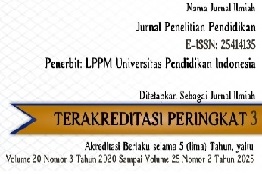Zoom-Storytelling : an Activity to Reduce Students’ Speaking Anxiety
Abstract
Abstrak
Dari empat keterampilan bahasa Inggris, keterampilan berbicara merupakan keterampilan yang paling sulit bagi siswa. Banyak alasan yang membuat siswa enggan berbicara bahasa Inggris, antara lain takut ditertawakan oleh temannya dan kurangnya rasa percaya diri. Faktor-faktor tersebut membuat siswa merasa cemas untuk berbicara dalam bahasa Inggris. Sejak diterapkannya pembelajaran dari rumah oleh pemerintah pusat akibat merebaknya Covid-19, siswa semakin tidak pernah berlatih berbicara dalam bahasa Inggris. Hal tersebut memperburuk tingkat kecemasan siswa untuk berbicara bahasa Inggris. Oleh karena itu, penelitian studi kasus kualitatif ini dilakukan untuk membantu mengurangi kecemasan siswa dalam berbicara bahasa Inggris dengan menggunakan zoom-storytelling, terutama ketika mereka diharuskan belajar dari rumah. FLCAS digunakan untuk mengukur tingkat kecemasan siswa. Hasil penelitian menunjukkan bahwa zoom-storytelling dapat mengurangi tingkat kecemasan siswa dalam berbicara bahasa Inggris. Melalui kegiatan zoom-storytelling ini, siswa terbantu untuk mendapatkan pembelajaran tatap muka secara virtual meskipun tidak berada di sekolah.
Kata kunci: Aplikasi Zoom, Storytelling, Speaking Anxiety.
Abstract
Among the four English skills, speaking is the most difficult skill for students. Many reasons make students reluctant to speak English, including being afraid of being laughed at by their friends and lack of confidence. These factors make students anxious to speak English. Since the implementation of learning from home by the central government due to the outbreak of the Covid-19, students have increasingly never practiced speaking English. It worsens the level of students' anxiety to speak English. Therefore, this qualitative case study research was conducted to help to reduce students' anxiety in speaking English by using zoom-storytelling, especially when they were required to learn from home. FLCAS was used to measure the student's anxiety level. The results showed that zoom-storytelling can reduce students' level of anxiety in speaking English. Through this zoom-storytelling activity, students were helped to get learning face-to-face virtually even though they were not in school.
Keywords: Zoom Application, Storytelling, Speaking Anxiety.
Keywords
Full Text:
PDFReferences
Abbasi, M., & Behjal, F. (2018). The effect of storytelling via telegram on Iranian EFL learners' speaking complexity. International Journal of Educational Investigation , 5(2), 28-40.
Atta-Alla, M. (2012). Integrating language skills through storytelling. English Language Teaching , 5(12).
Bruner, J. (1990). In Contemporary Theories of Learning. Learning Theorists .... in Their Own Words. Edited by Knud Illens. London and New York : Routledge.
Connolly, S., & et.al. (2006). Anxiety Disorder. New York: Chelsea House Publisher.
Gils, F. V. (2005). Potential applications in digital storytelling in education. 3rd Twente Student Conference on IT.
Horwitz, E. K., Horwitz, M., & Cope, J. (1986). Foreing Language Classroom Anxiety. The Modern Language Journal, 70(2) , 125-132.
Juhana. (2012). Psychological Factors that Hinder Students from Speaking in English Class (A Case Study in a Senior High School in South Tangerang, Banten, Indonesia). Journal of Education and Practice, 3 , 12.
Lavefer, S. (2009). Are national curriculum objectives for teaching English being met in Iceland compulsory school? Timarit um menntarannsoknir , 6, 107-128.
Liu, M. (2007). Anxiety in oral English classroom: A case study in China. International Journal of English Language Teaching , 3(1).
Nunan, D. (1999). Second Language Teaching and Learning. Boston: Heinle Publishers.
Nunan, D. (1988). Syllabus Design. Oxford: Oxford University Press.
Ono, Y. (2014). Effects of digital storytelling and Japanese EFL learners. Focus on anxiety and PBL skills. New Perspectives on the development of communicative and related competence in foreign language. Language Arts & Diciplines .
Punsiri, B. (2011). The Effectiveness of Drama Techniques on Foreign Language Classroom Anxiety Reduction of Thai EFL Students. (Thesis). Thailand: Srinakharinwirot Univeristy.
Rachman, S. (1998). Anxiety. East Sussex: Psychology Press.
Rahmawati, I. (2014). Teaching Speaking Through Storytelling. S2 Thesis. Bandung: Universitas Pendidikan Indonesia.
Saglamel, H., & Kayaoglu, M. N. (2013). Creative Drama: A Possible Way to Alleviate Foreign Language Anxiety. RELC Journal, 44(3) , 377-394.
Samantaray, I. (2014). Use of story telling method to develop spoken English skill. International Journal of Language & Linguistics , 1(1)
Sharma, D. (2018). Action research on improving students' speaking proficiency in using cooperative storytelling strategy. Journal NELTA Surkhet , 5, 97-105.
Thorpe, S. (2011). Using storytelling in the facilitation of online goups. International Association of Fasilitators , 11, 24-39.
Woodrow, L. (2006). Anxiety and Speaking English as a Second Language. RELC Journal .
Wright, A. (1995). Storytelling with Children : Resource books for Children. Oxford: Oxford University Press.
Yin, R. (2009). Case Study Research: Design and Methods. Los Angeles: Sage.
Zuhriyah, M. (2017). Storytelling to Improve Students' Speaking Skill. Journal Tadris Bahasa Inggris , 119-134.
DOI: https://doi.org/10.17509/jpp.v21i2.36653
Refbacks
- There are currently no refbacks.
Copyright (c) 2021 Jurnal Penelitian Pendidikan


